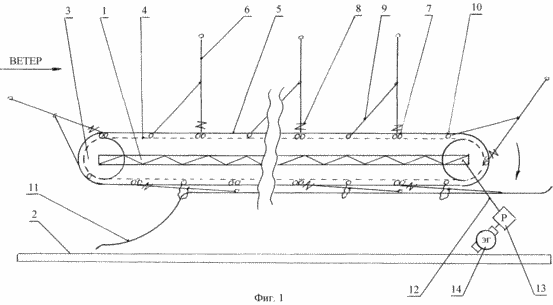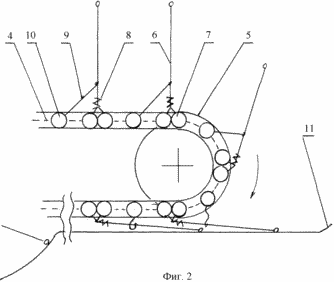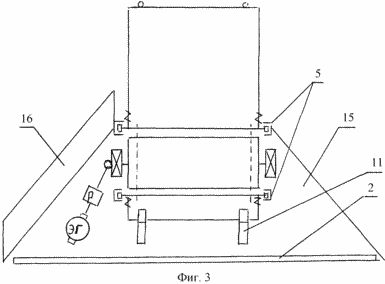| Start of section
Production, amateur Radio amateurs Aircraft model, rocket-model Useful, entertaining |
Stealth Master
Electronics Physics Technologies Inventions |
Secrets of the cosmos
Secrets of the Earth Secrets of the Ocean Tricks Map of section |
|
| Use of the site materials is allowed subject to the link (for websites - hyperlinks) | |||
Navigation: => |
Home / Patent catalog / Catalog section / Back / |
|
INVENTION
Patent of the Russian Federation RU2231685
![]()
Wind turbine for wind turbine
The name of the inventor: Kolesnikov E.Yu. (RU); Kolesnikov Yu.V.
The name of the patent holder: Mari State Technical University
Address for correspondence: 424024, Yoshkar-Ola, pl. Lenina, 3, MarSTU, Department of Intellectual Property
The effective date of the patent: 2002.10.15
The invention relates to a device that converts wind energy into mechanical energy of shaft rotation and then converts it into electrical energy. The technical result of creating an apparatus capable of developing high power in the surface wind layer is provided by the fact that in a windmill comprising semi-rigid blades with return springs fixed on an endless chain spaced on the drums according to the invention, the drums are arranged in a horizontal plane , While the folding semi-rigid blades held in the working position by flexible ties are mounted on trolleys hooked over an endless chain with the ability to move along the carrying rail, the flexible screeds in turn are fixed to the intermediate carriages, and are engaged in an endless chain with the ability to move along The semi-rigid blades for idling are folded and held in the folded state by a shaped support, the whole device is oriented at an angle ![]() = 20-45º to the direction of the wind, and to stop the windmill - at an angle
= 20-45º to the direction of the wind, and to stop the windmill - at an angle ![]() = 90º to the wind.
= 90º to the wind.
DESCRIPTION OF THE INVENTION
The present invention relates to a device that converts wind energy into mechanical energy of shaft rotation and then converts it into electrical energy.
The closest analogue (prototype) is the technical solution described in application No. 97113109, cl. MKI F 03 D 5/02, author Batalov SS A well-known windmill includes semi-rigid sails suspended on axles fixed at their ends on two parallel endless flexible elements (cables, chains) stretched onto the wheels, which contains stops for turning restrictions.
It is an object of the present invention to provide an apparatus capable of developing high power in the surface wind layer.
The goal is achieved by the fact that the windmill includes semi-rigid blades with return springs fixed on an endless chain spaced on drums that are located in a horizontal plane, while folding semi-rigid blades held in working position by flexible ties are mounted on trolleys meshed with an endless chain With the ability to move along the supporting rail, while the semi-rigid blades for idling are folded and held in the folded state by a shaped support. The whole device is oriented at an angle ![]() = 20 ÷ 45º to the direction of the wind, and to stop the windmill - at an angle
= 20 ÷ 45º to the direction of the wind, and to stop the windmill - at an angle ![]() = 90º to the wind.
= 90º to the wind.

In Fig. 1-4 shows a general view of a windmill consisting of a frame 1 mounted on a turntable 2, drums 3 fixed to a frame, an endless chain 4, carrying rails 5 (Figures 1, 2), folding semi-rigid blades (sails) 6, Mounted on the carts 7, the return springs 8, the flexible ties 9, the intermediate trolleys of the tie rods 10, and the linkage of the folded blades 11, (Figures 1, 2, 3) of the power take-off shaft 12 connected to the chain 4, A speed-increasing reducer 13, an electric generator 14, a cowl-fairing 15 (Figures 3, 4) that covers the bottom of the device from the wind to the ground and has air flow guides, ridges 16 on the windward side.
 |
 |

Operation of the device. Under wind pressure, the blade 6 mounted on the carriage 7 rolls along the rail 5, dragging the attached chain 4 and rotating the drums 3. The tipping blade is held by the screed 9 meshed by the intermediate carriage 10 and rolling on the rail 5. Having reached the end of the frame 1, the trolley 7 is lowered down the drum 3, and the blade held by the screed is deflected backward, compressing the return spring 8. With further downward movement, the upper edge of the blade is supported by a roller on the shaped support 11, the blade is folded, the screeds relax and freely sag. In this position they remain to the end of the rectilinear portion of the shaped support. Having reached the beginning of the frame, the trolley with the base of the blade rises up the drum, and the upper edge of the blade is lowered under the action of the spring, "rolling" along the "retreating" section of the shaped support, gradually straightening the screeds to tension and striving to occupy the vertical ("radial") drum position. However, the blade is held by stretched screeds, so in the "working" position it rises smoothly, gradually picking up the wind. In this case, the wind pressure of all the blades of the "working" branch of the chain is summed into the total force of the windmill, transferring the torque from the drum 3 through the power take-off shaft 12 to the energy consumers. Taking into account that the device is slow-moving, the movement from the shaft is transmitted to the speed-increasing reducer 13, and from it to the electric generator 14. These units are located on the turntable 2, under the bonnet-fairing 15 (Fig.3).
The fairing, closing the lower part of the device, smoothly directs the air flow upward, into the blade working area, using ridges 16. In order for the blades not to create a "wind" shadow to each other, the entire device is oriented at an angle ![]() = 20 ÷ 45º to the direction of the wind (Figure 4). At the same time, in a safe, non-working position, the device is installed at an angle
= 20 ÷ 45º to the direction of the wind (Figure 4). At the same time, in a safe, non-working position, the device is installed at an angle ![]() = 90º to the wind.
= 90º to the wind.
Despite the low efficiency of wind turbines, given the free and wind energy potential, a simple, cost-effective installation is created, the power of which is determined by the size of the blades and the length of the chain.
CLAIM
1. A wind turbine comprising semi-rigid blades with return springs fixed on an endless chain spaced on the drums, characterized in that the drums are arranged in a horizontal plane, while the folding semi-rigid blades held in working position by flexible ties are mounted on trolleys meshed for an infinite Chain with the ability to move along the supporting rail, flexible ties, in turn, are fixed to the intermediate carriages, and linked to an endless chain with the ability to move along the carrying rail.
2. The wind turbine according to claim 1, characterized in that the semi-rigid blades for idling are folded and held in a folded state by a shaped support.
3. The wind turbine according to claim 1, characterized in that to exclude the "wind shadow" of the blades, the entire device is oriented at an angle ![]() = 20 ÷ 45º to the direction of the wind, and to stop the windmill - at an angle
= 20 ÷ 45º to the direction of the wind, and to stop the windmill - at an angle ![]() = 90º to the wind.
= 90º to the wind.
print version
Publication date 31.01.2007gg




Comments
Commenting on, remember that the content and tone of your message can hurt the feelings of real people, show respect and tolerance to your interlocutors even if you do not share their opinion, your behavior in the conditions of freedom of expression and anonymity provided by the Internet, changes Not only virtual, but also the real world. All comments are hidden from the index, spam is controlled.